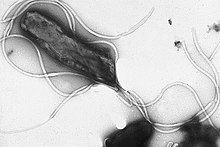Flagelline
Flagellins are a group of proteins in flagella (synonymous flagella ) of bacteria and archaea . In connection with the motor proteins at the base of the flagella, they are used for locomotion in liquids.
properties
Flagellins are the main component of flagella, which are made up of 20,000 to 30,000 helically arranged flagellin units. They are glycosylated globular proteins with a mass between 30 and 60 kilodaltons and spontaneously assemble into hollow cylinders with an inner diameter of about 2 nm . The outer diameter is 20 nm. The transport of the flagellins out of the cytosol takes place within the cylinder partly with the help of chaperones . In bacteria, flagella growth occurs at the distal end of the flagella, in archaea at the proximal end. With the periodic change in the direction of rotation (from clockwise to counterclockwise and vice versa) bacterial flagella briefly break up into individual filaments, archaic flagella do not. The flagella hook binds to flagellin at the base of the flagella, and a lid protein binds to the tip of the flagella.
Bacterial flagellins have a different mass, but a conserved N - and C -terminal , which ensures that they are aggregated to form the flagellum. Both terms lie on the inside of the flagellum and control the assembly of the flagellin into two different protofilaments, long and short. The middle part of the flagellin lies on the outside of the flagella and is comparatively variable between the species . The protein domains of the flagellin are numbered from the inside out (D0 to D3), with both terms in the domain D0. The ratio of long and short protofilaments determines the turn of the flagellum. While in most flagellated bacterial species there is only one flagellin (in Escherichia coli coded by the gene fliC ), Sinorhizobium meliloti , Treponema pallidum and Caulobacter crescentus (in C. crescentus coded by the genes fliM , fliN and fliO ) have several related flagellins.
immunology
In mammals, the toll-like receptor 5 (TLR5) binds to flagellins, which activates the innate immune response in epithelial cells and dendritic cells . In dendritic cells, the formation of T helper cells for the adaptive immune response is also stimulated. Therefore flagellins are being studied as adjuvants . Analogously, flagellins trigger an innate immune response in plants , in particular the flagellin peptide flg22 . In the thale cress ( Arabidopsis thaliana ) flagellin binds to the receptor - protein kinase FLS2 (of English. Flagellin-sensitive-2 ), whereupon BAK1 (of English. BRI1-associated kinase 1 ) is bound and the innate immune response is triggered.
Individual evidence
- ↑ Keiichi Namba, Ferenc Vonderviszt: Molecular architecture of bacterial flagellum. In: Quarterly Reviews of Biophysics. 30, p. 1, doi : 10.1017 / S0033583596003319 .
- ↑ a b c d e Stanley Falkow: The Prokaryotes. Springer Science & Business Media, 2006, ISBN 978-0-387-25492-0 , p. 106.
- ↑ N. Sharma, AS Akhade, A. Qadri: Sphingosine-1-phosphate suppresses TLR-induced CXCL8 secretion from human T cells. In: Journal of leukocyte biology. Volume 93, Number 4, April 2013, pp. 521-528, doi : 10.1189 / jlb.0712328 , PMID 23345392 .
- ^ A b A. Vijayan, M. Rumbo, C. Carnoy, JC Sirard: Compartmentalized Antimicrobial Defenses in Response to Flagellin. In: Trends in Microbiology. Volume 26, number 5, 05 2018, pp. 423-435, doi : 10.1016 / j.tim.2017.10.008 , PMID 29173868 .
- ↑ B. Cui, X. Liu, Y. Fang, P. Zhou, Y. Zhang, Y. Wang: Flagellin as a vaccine adjuvant. In: Expert review of vaccines. Volume 17, number 4, 04 2018, pp. 335-349, doi : 10.1080 / 14760584.2018.1457443 , PMID 29580106 .
- ↑ IA Hajam, PA Dar, I. Shahnawaz, JC Jaume, JH Lee: Bacterial flagellin-a potent immunomodulatory agent. In: Experimental & molecular medicine. Volume 49, number 9, 09 2017, p. E373, doi : 10.1038 / emm.2017.172 , PMID 28860663 , PMC 5628280 (free full text).
- ↑ SB Mizel, JT Bates: Flagellin as an adjuvant: cellular mechanisms and potential. In: Journal of immunology. Volume 185, number 10, November 2010, pp. 5677-5682, doi : 10.4049 / jimmunol.1002156 , PMID 21048152 , PMC 3756556 (free full text).
- ↑ AV García, H. Hirt: Salmonella enterica induces and subverts the plant immune system. In: Frontiers in Microbiology. Volume 5, 2014, p. 141, doi : 10.3389 / fmicb.2014.00141 , PMID 24772109 , PMC 3983520 (free full text).
- ↑ D. Chinchilla, T. Boller, S. Robatzek: Flagellin signaling in plant immunity. In: Advances in Experimental Medicine and Biology . Volume 598, 2007, pp. 358-371, doi : 10.1007 / 978-0-387-71767-8_25 , PMID 17892224 .
- ↑ AV García, H. Hirt: Salmonella enterica induces and subverts the plant immune system. In: Frontiers in Microbiology. Volume 5, 2014, p. 141, doi : 10.3389 / fmicb.2014.00141 , PMID 24772109 , PMC 3983520 (free full text).
- ↑ D. Chinchilla, C. Zipfel, S. Robatzek, B. Kemmerling, T. Nürnberger, JD Jones, G. Felix, T. Boller: A flagellin-induced complex of the receptor FLS2 and BAK1 initiates plant defense. In: Nature . Volume 448, number 7152, July 2007, pp. 497-500, doi : 10.1038 / nature05999 , PMID 17625569 .

